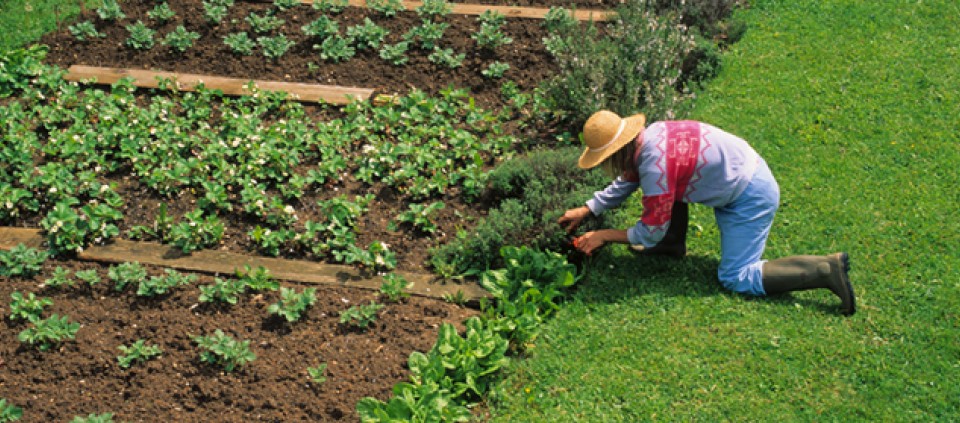Garden Therapy

When my husband and I moved into this apartment, our backyard was a strip of dirt that lay between our stairs and the garage. Construction debris was scattered throughout, and a rusty stove sat at one end. Once the junk was cleared away, I saw that this dirt was also home to a beleaguered rose bush.
A month later, the arrival of spring triggered a new desire in me, the perpetual tenant with homeowner envy: I wanted to try my hand at gardening. My husband set out to help me one day by weeding out the unruly bits of green that were starting to emerge where the debris had been. In his zeal, he hacked the rose bush down to a stub. I was worried.
Several weeks and a few doses of fertilizer later, I witnessed a small miracle: leaves, then buds, then flowers—deeply crimson—coming forth from the rose bush. I began checking it every day like an obsessive mother, cooing over new blossoms and carefully pruning any overgrowth. Encouraged, I bought some petunias, pansies, and verbena to fill in the developing garden. We added beach rocks for accent and optimistically planted tomatoes, basil, and oregano for our summer meals.
Soon roots and crawly creatures had replaced the Styrofoam cups, cigarette butts, and nails that had previously occupied the dirt. I was thrilled and soothed by this thing of beauty and wonder that we were cultivating outside our back door, and I spent a lot of time just staring at it. I also stopped to smell the abundant roses, grateful for their sweet perfume.
Five years later, I’ve filled the garden with perennials, climbing vines, and transplants from generous neighbors and my parents’ yard. I’ve scattered novelties and shiny objects amid the flowers, including a solar-powered globe that glows multiple colors at night—eerily thrilling! For a dabbler like me, gardening offers endless creative fun and a chance to redesign nature. Even the French impressionist painter Claude Monet called his garden his “greatest masterpiece.”
Most mornings I walk out the back door, tea in hand, to see what’s bloomed since sunrise, and snip a few pansies for a tiny vase in the kitchen. That’s when my cat (Sweet Pea, coincidentally) takes the opportunity to passionately nuzzle my arms and legs as I walk around to prune and deadhead. It’s often the most affection she shows me all day, and I think she’s picking up on the love that I feel for this patch of nature, which loves me back with each new leaf and blossom.
Who knew I could fall in love with a garden? Well, maybe my (arborist) father and my (garden club president) mother, who still encourage me to raid their yard for transplants. Afterwards, I call them to report on the status of the hostas, the lady’s mantle, the lilies, or the digitalis, sending pictures the way other women send photos of the grandkids. Perhaps that’s because these delightful bits of flora are the only things I’ll be raising in this lifetime.
It’s not as if I know what I’m doing out there in the soil. In fact, my garden teaches me a lot about failure (the Brussels sprouts that never sprouted), resilience (the aforementioned rosebush), patience (as I wait for the perennials to emerge so I can remember what I planted last year), and tolerance (beetles and leaf mites and squirrels, oh my!). It also stirs sweet memories of the small strawberry patch that I fussed over as a kid.
As a freelance writer and teacher who works from home, I appreciate the gentle, healing companionship that my garden offers me. It slows down my churning mind, unplugs me from electronic demands and puts me in a state of flow and appreciation. According to my positive psychology professor Tal Ben-Shahar, these things can boost mood, self-esteem, and overall happiness.
“I know you love your garden,” said my husband the other day—after I disappeared for an hour when I was supposed to be making us both some coffee. I grinned, clippers in hand, as he wiped a smudge of dirt from my forehead. Sometimes I find him watering our garden in a kind of meditative trance, connecting with the earth as he disconnects from his workaday concerns.
I once saw a funny, anonymous quote that went like this, “Gardening is cheaper than therapy. And you get tomatoes.” Along with some roses and a little bit of heaven.
Kim Childs is a Boston-based life and career coach and writer who specializes in Positive Psychology. She is also a Kripalu Yoga teacher and facilitator of workshops based on The Artist's Way: A Spiritual Path to Higher Creativity, by Julia Cameron.
© Kripalu Center for Yoga & Health. All rights reserved. To request permission to reprint, please e-mail editor@kripalu.org.
Kim Childs is a Boston-area life and career coach specializing in Positive Psychology, creativity, and spiritual living. She writes for Kripalu.
Full Bio and Programs